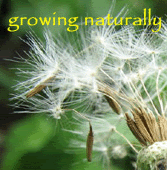"Life in its entirety is like a plant. The plant contains not only what it offers to external life; it also holds a future state within its hidden depths. One who has before him a plant only just in leaf, knows very well that after some time there will be flowers and fruit also on the leaf-bearing stem. In its hidden depths the plant already contains the flowers and fruit in embryo; yet by mere investigation of what the plant now offers to external vision, how should one ever tell what these new organs will look like? This can only be told by one who has learnt to know the very nature and being of the plant." - From The Education of the Child, Ruldolph Steiner.
In modern textbook education many subjects are taught one page or one chapter at a time. The teacher will set aside a couple hours to teach the children "how to do division" and then will assign problems and continue to assign problems with progressive difficulty. Or, a teacher may explain what the subjunctive is and then have children practice marking these in sentences. No matter what the subject, the rhythm is often standard - teach the subject, practice the problems, answer some questions, and students who don't understand get the lower grade.
What is missing in this method (and I call it a method rather than attaching it to a certain place of education or name of an educational philosophy because you can find this method in many different systems) is an understanding of the quote above. People bloom like plants. Children bloom like plants and blooming is not something that happens so instantaneously. One cannot touch a rose bud, chant a little and it will open. One must slowly coax it out into the sunlight with a little water, some gentle breeze, rays of sun and most importantly - time.
When a child is given this time to really get to know a subject and become comfortable with it the fear related to that subject will vanish and they will truly learn instead of just "learning enough" to get by and go on with the next subject. This means that as a teacher we must be patient.
The most important part of teaching is not always what the child is taught but how and when they are taught. The teacher first presents the material in a gentle way. The children are not expected to fully understand or be able to mimic the process at this point. In this stage the children are simply expected to "encounter" the material. The children are then given a day to reflect on this encounter either consciously and/or subconsciously (during sleep). This process typically takes one day but it could take more if you are teaching at home and have more freedom with time. If your child needs more than one day with this stage, consider giving them more time. Sometimes I may even go through all the stages with my child and if they still are not easily grasping the subject I will set it aside and come back to it again in a week or a month. Miracles often happen during that week or month!
From this encounter comes experience. The second day the child is asked to participate in the learning process either through verses, painting, drawing, copying from the board, movement or other tasks. However, there is still no pressure on them to actually completely understand the material or to be able to "spit it out" again onto a worksheet or during a test. This stage may last a few days. There may be stories, paintings, movement, and many other experiences related to this concept.
Finally, when it is the right time for the class (as I said before, teaching at home you have more freedom with this time-line) the experience naturally crystallizes into the concept itself. You will find that some children will "suddenly" understand the concept and will be able to explain it and complete tasks. Their "buds" in this topic have bloomed.
Other students may need more time. In this case you should give them more time. To force a bud to bloom before its time can result in the petals being ripped apart, and falling to the ground. It is often hard to recover this bud and create a whole and beautiful flower from it later. One can force the child to finish the worksheets and projects and "half-understand" the concepts but their flower will be filled with petals that are glued onto the stem, always falling off and having to be put back on...and some petals may be missing. This "flower" may hate the subject for the rest of their lives or develop a fear of performing in that subject that will prevent them from growing in other areas. Or, they may simply not feel an affinity to the subject and will find it undesirable the rest of their lives. This could be why some children grow up and don't enjoy reading books, writing letters to friends, or doing anything related to math.
Perception, feeling, idea - these are the three steps in the genuine learning process that prepares the intellect for the abstract and conceptual thinking that will become possible later in adolescence.
When I think of this in terms of rhythm I think of the first method being akin to a marching band. There is a strict drum rhythm and everyone needs to keep the beat - ONE-two-three, ONE-two-three, ONE-two-three. When I think about the rhythm of Waldorf education I think more of the rhythm of a river...flowing instead of beating, with one idea flowing into another flowing into another and so on...until it reaches the ocean of adolescence.
Friday, February 19, 2010
The Rhythm of Learning
Posted by
Kristie Karima Burns, MH, ND
at
8:47 AM
![]()
Labels: Middle Grades, NEW BLOG, Rhythm
Subscribe to:
Post Comments (Atom)










8 comments:
Thank you for writing about Rhythm and the Flow of learning.
Do you have any advice for parents that are just coming to Waldorf and have a child, who bc of previous mainstream reading curriculum has a resistance to reading?
Great post! Real learning is a discovery process, not a checklist of required skills.
I love your comparisons. What an inspiring post. Thank you!
Beautiful illustration of our need for patience with a child's learning process. I am always struggling to have this patience. Would you mind giving a concrete example of this rhythm - as in how to incorporate art, movement, etc. into learning multiplication for instance?
I'd love some specific examples as well! My LO is far off from any sort of schooling, but I hear such great things surrounding Waldorf! At the moment we are interested in Sudbury Schooling or unschooling as I feel that a child will naturally develop interests that will assist them throughout their lives...that there IS no need to go about "introducing" topics. I'd love to hear some thoughts on this from a Waldorf perspective if you'd care to address it!
Great blog!
Wonderful blog and post!
Very beautifully said, thank you.
The Butterfly
by Kazantzakis from Zorba the Greek
I remember one morning when I discovered a cocoon in the back of a
tree just as a butterfly was making a hole in its case and preparing
to come out. I waited awhile, but it was too long appearing and I was
impatient. I bent over it and breathed on it to warm it. I warmed it as
quickly as I could and the miracle began to happen before my eyes,
faster than life. The case opened; the butterfly started slowly
crawling out, and I shall never forget my horror when I saw how its
wings were folded back and crumpled; the wretched butterfly tried
with its whole trembling body to unfold them. Bending over it, I tried
to help it with my breath, in vain.
It needed to be hatched out patiently and the unfolding of the wings
should be a gradual process in the sun. Now it was too late. My
breath had forced the butterfly to appear all crumpled, before its time.
It struggled desperately and, a few seconds later, died in the palm of
my hand.
That little body is, I do believe, the greatest weight I have on my
conscience. For I realize today that it is a mortal sin to violate the
great laws of nature. We should not hurry, we should not be
impatient, but we should confidently obey the external rhythm.
Offered by Christine Natale
Post a Comment